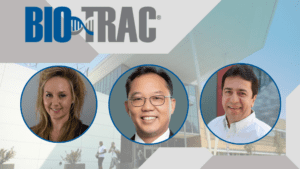
New Director of TEDCO’s University Commercialization Fund Shares Vision for the Future
June 6, 2018
The Maryland Innovation Initiative (MII) is the State’s premier $5.8M investment program for validating and commercializing University research into new technology products and companies. Run by TEDCO, MII is touted as one of the most innovative tech transfer and commercialization programs across the country. Under the new TEDCO 2.0 vision, MII is now poised to get even better, and Arti Santhanam, Ph.D. was recently appointed as the new MII Program Director to help make that happen.
Since its launch in 2012, TEDCO’s Maryland Innovation Initiative (MII) has invested $29M+ into 58 university startups, and 150+ University projects. That $29M has been leveraged to attract $140M in follow-on funding for those companies and generate some big exits as a result. The most recent of which was Harpoon Medical that was acquired for $100M last December by Edwards Lifesciences Corporation (NYSE: EW).
Dr. Santhanam has been with TEDCO since 2014 and brings over 20 years of industry experience to the new role. She will direct and manage all program elements to continue to make MII the best program in the country for technology commercialization. I had the opportunity to talk to her and get her thoughts on MII and her vision for the future.
***
Congratulations on the promotion! You’ve been at TEDCO since 2014, so how has your role evolved to prepared you to run MII?
Arti: Thank you. I’m proud that I’ve started or been part of so many things during my time at TEDCO. When I first joined this innovative organization, I was part of the MII program and I worked to manage our active investments and develop some of the metrics of the program. I then got to help with the creation of the Life Science Investment Fund, which I managed for 2 years, to bridge the gap between pre-seed and venture investments. I also worked with the Maryland Venture Fund as a life science analyst. I’m probably one of the lucky people who has seen the length and breadth of all the programs at TEDCO. It’s been a great learning experience that will help in this new role. Going from pre-seed, to seed, to venture fund and back I’ve been able to move through and participate in all of the programs and that is something that I’m personally proud of that gives me the tools to be successful in running MII.
What’s your vision for the future of MII?
Arti: MII has been around for 5 years and we have excellent metrics in terms of what our mission is and how we’ve matured the innovation ecosystem. My colleague Jennifer Hammaker launched the program and has laid a tremendous foundation of success to build on. The contributions of MII award manager Dr. John Gustin, who works tirelessly in guiding each project and company through our program and admin extraordinaire, Silvia Goncalves, who manages all our financial interactions with 5 different universities is the icing on top. So what more can we do?
As our entrepreneurial ecosystem evolved and matured over the last 5 years, so too has TEDCO. The TEDCO2.0 strategy is all about being faster, leaner, better and more flexible with what we do. So, what I plan to do is align MII with the vision our CEO George Davis has for TEDCO and see how we can be more nimble, open, and available to both our university partners and our entrepreneurial ecosystem.
I’m beginning by talking to all board members that represent the MII Universities on how to improve this program. We are sitting down to discuss how we can make the program more flexible, and also if there are parts of the program that don’t work now that might need changed. I’m also reaching out to our prime partners- university tech transfer offices and incubators to see if we can complement or enhance their individual efforts. I’m also looking at what SBIR programs and other states are doing to see what models work and what we should do differently. It’s time to dig deeper and find out what else we can provide.
We’ve done a number of successful projects on the side, like sponsored I-Corps programs and held MII CEO roundtables where founders can build relationships and learn together. We’ve brought in firms like WSGR, Mintz Levin and others to run workshops for MII companies and really built a variety of great resources around MII participants. I want to build on those accomplishments and see how we can we match MII’s strategy to the changes that are happening with TEDCO’s Gateway Services programs, such as access to better management services, education, fund raising, CEO matchmaking and executive placement. We don’t want to diminish the quality and quantity of companies we produce each year, or the integrity of the program. At the same time, we want to maintain a level playing field across the MII Universities. We want to treat them all the same, as long as the technologies are on-par across the university participants.
I’m looking at this with a blue-sky approach towards what an MII-TEDCO 2.0 program would look like. If there are ways to be more flexible or add complimentary programs that increase value, then we want to explore it.
Why is MII so important to the region?
Arti: MII was established to spur and accelerate transition of promising technology that would have otherwise sat on the shelf at tech transfer offices and get it into the commercial space. The goals are to leverage the tremendous research dollars that go into Maryland’s research universities and spin out startup companies or license that technology into existing companies. This builds the entrepreneurial ecosystem, creates jobs and brings more investment dollars into Maryland, not to mention retain the highly educated workforce we train in our schools and universities.
What makes MII stand out against other early stage university investment programs?
Arti: When you compare MII to what exists in other states we are unique in structure and processes. First, MII is unique in how its run. A critical component of MII is that the process includes site-miners who are professionals that have experience looking for technology for commercialization and are hired by universities to ‘mine’ each of the sites. Their role is to talk with faculty, explain what commercialization means, hold the founder/inventor’s hand to help them through the MII phases, advocate for applicants and commercialization and then help find the team to build around the technology. You don’t find this in other programs around the country. Site miners are the secret sauce. Site miners also help to keep the quality of technology and startups high that’s reflected in our 20-30% startup formation success rate, which is unheard of for other programs that act at this early stage for tech transfer. Our panel of 20+ external reviewers are also important in both holding the standard of our program high while providing an unbiased level playing field for all university applicants.
Secondly, MII’s unique structure comes from the state legislative statute, but it is also a pay to play program since the 5 participating universities put their skin in this game alongside the State. MII is funded each year by The University of Maryland, Baltimore (UMB), University of Maryland, College Park (UMCP), University of Maryland Baltimore County (UMBC), Johns Hopkins University (JHU) and Morgan State University (MSU), in addition to the State. Thus the success of this program is imperative to both the State of Maryland and the University partners.
Lastly, it’s unique in that MII is technology agnostic. We accept any tech w/ IP protection (copyright, patent). Variations of our investments include Living Canopies out of College Park who has created green-tech driven natural sustainable canopies for restaurants and hotels. Cycloburn out of Morgan State is an Ag-tech company that developed an elegant solution for disposing off waste from poultry farms while generating power and represents MSU’s first technology transfer licensing contract. Harpoon Medical out of UMB is developing a medical device in the cardiac space whereas Asclepix, a Hopkins company is developing therapies for retinal diseases and cancer. We also invest in drones, cyber security, and other technologies. We truly reflect all that Maryland universities offer in high tech industry.
#ThrowbackThursday – The BioBuzz on Harpoon Medical’s CEO Bill Niland via original post from 2014 by @JamieLaceyPR cc @EdwardsLifesci @MDTEDCO @abellfoundation @UMVentures https://t.co/76lgL1Kcyb
— BioBuzz (@BioBuzzMaryland) April 26, 2018
What is your investment model for commercializing these early stage technologies?
Arti: We help invest in these companies at two levels. The first starts through tech transfer offices where we provide up to $115K as a grant for technology assessment funding to validate technology and assess the market potential. If a technology has a commercial prospect, then we can help with an investment of $150K for technology commercialization and company formation. The startup company must license the IP from the qualifying university and demonstrate a viable team that can commercialize this technology to qualify for the second phase investment. Our investment now helps the company move beyond validation to helping them create real value in the product to commercialize it. The funds are typically used towards FDA approval, to build alpha or beta prototypes, QC methodology, customer acquisition, product studies, etc. We also have a nine-month phase strategy which makes sure that these companies are moving at a fast pace to commercialize. This creates a sense of urgency, an industry-minded culture and shows investors that they are focused. This is what really helps to drive the follow-on investment into the startup.
What outcomes are you looking to achieve when working with new companies?
Arti: The main goal is transitioning technologies from the bench to the market. What we know is that this is only successful if you can grow companies that are poised to get follow on funding and can create more jobs, revenue, etc. It’s an important outcome for the survival of these companies and reflects the quality of companies spun out MII.
How does MII benefit follow on investment into companies and the ecosystem?
Arti: Through our rigorous process and portfolio management, we have made it a point to ensure that all the IP aspects of the technologies are tight with at least the minimal freedom to operate. When a partner investor comes to us to evaluate a company or technology we know that every ‘I’ has been dotted and ‘T’ has been crossed when it comes to de-risking the IP. Our partners appreciate that. MII is the most technically de-risked, IP secured vehicle to produce deal flow for the rest of the region.
MII is just the tip of the iceberg in terms of follow-on funds that a company could secure. MII fills the Maryland pipeline and produces some of the best deal flows for follow on investment from seed, angel and venture funds who partner, co-invest and do syndicates with other TEDCO downstream funds (eg. Orbimed, NEA, etc).
The other big advantage we provide is that investment partners from outside of Maryland get data that we have about the company, the CEO, culture, history of the product, technology, IP, etc that goes back for years. This gives them a level of trust and comfort in their investment. At MII, we are the boots on the ground for other out-of-state investors to meet good startups and invest in Maryland companies. We help them understand the companies and also find resources through TEDCO’s network. That’s the value TEDCO brings when they go into big syndicates.
Tell me about the foundation that’s been laid before you with the MII program?
Arti: In 2012 the tech transfer ecosystem wasn’t as strong as it is now so there was a lot of growing pain early on. When MII was launched it was a very novel concept to commercialize technology like this. Jennifer Hammaker and the MII team helped shape and mature the ecosystem when it came to tech transfer and putting the right processes in place. Her contribution was working through all the kinks early on that came with starting with a raw program and molding it into an efficient one. For example, there was a learning curve early on for our site miners, who “speak” industry and the academic innovators who “speak” science. We are a lot better in our communications now and the whole time we’ve maintained a high quality.
Jennifer will continue to stay involved, as she moves into her business development role at TEDCO where she will work with the University system on bigger projects that will have a valuable impact on the ecosystem goals, i.e. building out corporate partnerships and programs. I know that the future of MII will reflect all of her efforts, and she will be continuing to impact the success of the program in the future.
***
We thank Dr. Arti Santhanam for her time and insights into the MII program. Stay tuned for a second installment of this interview in an upcoming “In Conversation” with piece we are soon publishing on Arti as well.
For more on the MII program and other TEDCO investment programs visit www.tedco.md
Author:
Chris Frew, @Biotechmd
- About the Author
- Latest Posts
Over the past 11 years, Chris has grown BioBuzz into a respected brand that is recognized for its community building, networking events and news stories about the local biotech industry. In addition, he runs a Recruiting and Marketing Agency that helps companies attract top talent through a blended model that combines employer branding and marketing services together with a high powered recruiting solution.






